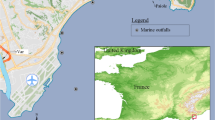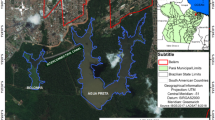Abstract
In this study, the impact of Escherichia coli emissions from a sewage treatment plant on the bathing water quality of Dublin Bay (Ireland) is assessed using a three-dimensional hydro-environmental model. Before being discharged, the effluent from the plant is mixed with cooling water from a thermal–electrical power generation plant, creating a warm buoyant sewage plume that can be 7–9°C higher and is less saline than the ambient water in the bay. The ability of the three-dimensional model in representing such a stratified condition is assessed based on a comparison of its results with two-dimensional modelling results. Hydrodynamic simulations of water levels and flow velocities in Dublin Bay were obtained using the TELEMAC-3D model in one case and the depth-averaged TELEMAC-2D model in the other. The results of each model were separately used as inputs to the water quality model SUBIEF-3D to simulate the transport and fate of E. coli in the bay and to generate maps of E. coli concentrations over the bay. In addition, the necessity for three-dimensional modelling in simulating the effects of wind direction on the dispersion of E. coli was demonstrated by comparing the results of three-dimensional and two-dimensional model simulations with a number of different wind directions. The comparison showed that the three-dimensional model performed better than the depth-averaged model in simulating the hydrodynamics and resulted in better simulation of the water quality processes in the bay. In particular, the three-dimensional model had reasonably simulated the timing of the delivery of E. coli to the bay. Moreover, the effect of wind on the movement of the buoyant plume of pollution and on the E. coli distribution was found to be more pronounced with the three-dimensional hydrodynamics. The results demonstrate the need for three-dimensional simulations in situations of density differences or significant wind influences.










Similar content being viewed by others
References
Ellis, K., White, G., & Warn, A. (1989). Surface water pollution and its control. Basingstoke: Macmillan.
Environmental Research Unit (1992). Dublin Bay Water Quality Management Plan: Recreation, Amenity, and Wildlife Conservation Study. Technical Report 1, Environmental Research Unit.
Central Statistics Office (2006). Ireland Principle Statistics 2006. http://www/cso.ie/statistics/population.htm.
EC (2006). Directive 2006/7/EC of the European Parliament and of the Council of 15 February 2006 concerning the management of bathing water quality and repealing Directive 76/160/EEC. Official Journal L064, 04/03/2006.
Falconer, R. A., & Lin, B. (1997). Three-dimensional modelling of water quality in the Humber Estuary. Water Research, 31(5), 1092–1102.
Falconer, R. (1984). A mathematical model study of the flushing characteristics of a shallow tidal bay. Proceedings of the Institute of Civil Engineers, 77, 311–32.
Falconer, R. A. (1986). A water quality simulations study of natural harbour. Journal of Waterway Port, Coastal Ocean Eng. ASCE, 112, 234–259.
DHI (Danish Hydaulic Institute) (2002). Mud transport module user guide, MIKE21 MT, DHI Software, DHI Water and Environment, Copenhagen, Denmark, 110 pp.
EDF-DRD (2001). TELEMAC modelling system, TELEMAC-2D, Principle Notes. V.3.0. Report No. HE-43/94/052/A.
Kashefipour, S. M., Lin, B., & Falconer, R. (2006). Modelling the fate of faecal indicators in a coastal basin. Water Research, 40(7), 1413–1425.
Kashefipour, S. M., Lin, B., Harris, E., & Falconer, R. A. (2002). Hydro-environmental modelling for bathing water compliance of an estuarine basin. Water Research, 36(7), 1854–1868.
Schnauder, I., Bockelmann-Evans, B., & Lin, B. (2007). Modelling faecal bacteria pathways in receiving waters. Proceedings of the Institution of Civil Engineers: Maritime Engineering, 160(4), 143–153.
Riou, P., Le Saux, J. C., Dumas, F., Caprais, M. P., Le Guyader, S. F., & Pommepuy, M. (2007). Microbial impact of small tributaries on water and shellfish quality in shallow coastal areas. Water Research, 41(12), 2774–2786.
Binliang, L., & Falconer, R. (1996). Numerical modelling of three-dimensional suspended sediment for estuarine and coastal waters. Journal of Hydraulic Research, 34, 435–456.
Hamrick, J. M. (1992). Estuarine environmental impact assessment using a three-dimensional circulation and transport model. Proceedings of the 2nd International Conference on Estuarine Coastal Model, pp. 292–303.
Walters, R. (1987). A model for tides and currents in the English Channel and southern North Sea. Advances in Water Resources, 10, 138–148.
Hervouet, J. (2007). Hydrodynamics of free surface flows: Modelling with the finite element method. Chichester: Wiley.
Kolluru, V. S., Buchak, E. M., & Brinkmann, P. E. (2003). Hydrodynamic modelling of coastal LNG cooling water discharge. ASCE Journal of Energy Engineering, 129, 16–31.
Hamrick, J. M., & Mills, W. B. (2000). Analysis of water temperatures in Conowingo Pond as influenced by the Peach Bottom atomic power plant thermal discharge. Environmental Science & Policy, 3(1), 197–209.
Marcos F, Janin J, Teisson C. (1997). Three-dimensional finite element modelling of thermal and chlorine discharges of a maritime nuclear power plant. Congress of the International Association of Hydraulic Research IAHR, VB pt 1, Environmental and Coastal Hydraulics: Protecting the Aquatic Habitat, pp. 329–334.
Ji, Z.-G., Hu, G., Shen, J., & Wan, Y. (2007). Three-dimensional modeling of hydrodynamic processes in the St. Lucie Estuary. Estuarine, Coastal and Shelf Science, 73(1-2), 188–200.
Kopmann, R., & Markofsky, M. (2000). Three-dimensional water quality modelling with TELEMAC-3D. Hydrological Processes, 14(13), 2279–2292.
Chao, X., Jia, Y., Shields, F. D., Jr., Wang, S. S. Y., & Cooper, C. M. (2008). Three-dimensional numerical modeling of cohesive sediment transport and wind wave impact in a shallow Oxbow lake. Advances in Water Resources, 31(7), 1004–1014.
Bai, Y., Wang, Z., & Shen, H. (2003). Three-dimensional modelling of sediment transport and the effects of dredging in the Haihe Estuary. Estuarine, Coastal and Shelf Science, 56(1), 175–186.
Hussey, M. (1996). Numerical modelling of cohesive sediment transport. Ph.D. thesis, University College Dublin, National University of Ireland.
Dowley, A., Qiang, Z. (1992). Dublin Bay Water Quality Management Plan, The Mathematical Model. Technical Report 4, Environmental Research Unit.
EDF-DRD (1997). TELEMAC modelling system. TELEMAC-3D. Version 2.2—Système de modélisation TELEMAC-3D Note Théorique, HE-42/97/049/B.
Flather, R. A. (1976). Results from surge prediction model of the North-West European continental shelf for April, November, and December 1973. Institute of Oceanography, (UK), Report No. 24.
Luck, M. & Guesmia, M. (2002). SUBIEF-3D Version 5.3, Manuel de l’utilisateur,HP-75/02/086/A. EDF R& D LNHE.
Falconer, R., & Chen, Y. (1996). Modelling sediment transport and water quality processes on tidal floodplains. In M. Anderson, D. Walling, & P. Bates (Eds.), Floodplain processes (pp. 361–398). Chichester: Wiley.
Bowie, G., Mills, W., Porcella, D., Campbell, C., Pagenkopf, J., Rupp, G., Johnson, K., Chan, P., & Gherini, S. (1985). Rates, constants, and kinetics formulation in surface water quality modelling. Technical report, U.S. Environmental Protection Agency. EPA/600/3-85/040.
Chapra, S. C. (1997). Surface water-quality modeling. Boston: MGraw-Hill.
Thomann, R., & Mueller, J. (1987). Principles of surface water quality modeling and control. New York: Harper and Row.
EDF-DRD (1998). TELEMAC Modelling system. Matisse User’s Guide Version 1.0. Report EDF HE-42/98/004/A.
Mansfield, M. (1992). Dublin Bay Water Quality Management Plan, Field studies of currents and dispersion. Technical Report 3, Environmental Research Unit.
Crisp, J. (1976). Survey of environmental conditions in the Liffey Estuary and Dublin Bay. Summary Report to the ESB and Dublin Port and Docks Board. Bangor: University College of North Wales.
Wilson, J. (2003). Diffuse inputs of nutrients to Dublin Bay. Proceedings of the 7th Diffuse Pollution and Basin Management Conference, Dublin, Ireland.
EDF-DRD (1997). TELEMAC modelling system. TELEMAC-3D. Version 2.2—User manual.
Bedri, Z. (2007). Three-dimensional hydrodynamic and water quality modelling of Dublin Bay. PhD thesis, University College Dublin, National University of Ireland.
Rohan, P. K. (1986). The climate of Ireland. Dublin: Meteorological Services.
KHO (1999). Admiralty Chart No. 1447, Dublin and Dun Laoghaire. Published at Taunton, United Kingdom under the Superintendence of Rear Admiral D.W. Haslam, Hydrographer of the Navy.
UKHO (1999). Admiralty Chart No. 1468, Arklow to the Skerries Islands. Published at Taunton, United Kingdom under the Superintendence of Rear Admiral D.W. Haslam, Hydrographer of the Navy.
Acknowledgements
This research has been jointly funded by the INTERREG IIIA (Ireland and Wales) project and the Marine Institute, Ireland.
The TELEMAC package has been developed by Electricité de France and supplied by Hydraulic Research Wallingford, UK under an academic license agreement.
Author information
Authors and Affiliations
Corresponding author
Additional information
Aodh Dowley had a considerable input to the material in the paper. He passed away before seeing the final version of it.
Rights and permissions
About this article
Cite this article
Bedri, Z., Bruen, M., Dowley, A. et al. A Three-Dimensional Hydro-Environmental Model of Dublin Bay. Environ Model Assess 16, 369–384 (2011). https://doi.org/10.1007/s10666-011-9253-7
Received:
Accepted:
Published:
Issue Date:
DOI: https://doi.org/10.1007/s10666-011-9253-7




